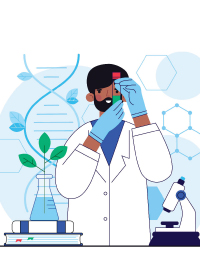Evaluation of novel culture media prepared from plant substrates for isolation and identification of Cryptococcus Neoformans Species Complex
Published on: 14th August, 2018
OCLC Number/Unique Identifier: 7844645048
Background: Melanin production due to phenoloxidase activity is a distinctive property of Cryptococcus neoformans and Cryptococcus gattii species complex yeasts. Therefore, an agar medium containing a precursor of melanin pigment is potentially useful to identify and differentiate cryptococcal colonies from other yeasts.
Background: This study aimed to evaluate and compare the ability of Cryptococcus neoformans species complex isolates to produce brown-pigmented colonies when grown on media prepared from various plant leaves or seeds extracts.
Material and Methods: Forty-six C. neoformans species complex isolates which were obtained from various environmental and clinical samples were inoculated on different media containing coriander, cumin, soybean, lupine, flax, pumpkin, basil, peppermint, and marjoram, were observed for the rate of growth and pigment production during a five-day period.
Results: All isolates were pigmented on all media within 24-48 hours, and brown or dark brown colonies were observed in less than five days, while C. albicans grew but did not produce any pigment.
Conclusion: The differential media tested in the present study are simple and inexpensive, and represent alternative valid tools for presumptive identification of C. neoformans species complex from clinical and environmental samples
Indian spices and Caffeine treatment for Obesity and Cardiovascular disease
Published on: 31st January, 2018
OCLC Number/Unique Identifier: 7355979500
The global obesity epidemic that was previously reported [1,2] is now to worsen with obesity to double in 73 countries around the world [3,4]. Improving the health of obese individuals by dietary restriction, anti-obese foods and increased physical activity [1] has not reduced the global obesity epidemic. Obesity is linked to nonalcoholic fatty liver disease (NAFLD) [5,6] with complications relevant to the metabolic syndrome and cardiovascular disease [7]. Appetite control has become critical to endocrinology and metabolism with the apelinergic pathway and nuclear receptor Sirtuin 1 (Sirt 1) now connected to the endocrine system [8] and critical to metabolism. The apelin-Sirt 1 interaction involves nitric oxide (NO) [9] that is now considered as the defect [10] in the interaction between the peptide apelin and calorie sensitive gene Sirt 1 involved in NO imbalances in the adipose tissue, liver and the brain.
Effects of dietary supplementation on progression to type 2 diabetes in subjects with prediabetes: a single center randomized double-blind placebo-controlled trial
Published on: 3rd February, 2023
Objectives: To examine the effect of dietary supplements on diabetic risk progression, blood glucose level, and lipid profiles.Methods: A randomized, double-blind, placebo-controlled study was conducted at Rajavithi hospital, Thailand. Participants with prediabetes were randomly allocated to three arms of dietary supplements: placebo (PL) or curcumin plus fish oil and vitamin D (CFD), or curcumin plus fish oil (CF) for 24 weeks. Primary outcomes were the progression of glycemic status and the progression to overt diabetes at 24-week and 36-week follow-ups. Secondary outcomes were changes in glycemic profiles (fasting plasma glucose, 75 g OGTT 2-h plasma glucose or HbA1C), body weight, BMI and lipid profiles.Results: A total of forty-seven participants (PL, n = 16; CFD, n = 15; CF, n = 16) were included in the study. At the 24-week follow-up, the participants with worsening glycemic status in the intervention groups were lower, CFD, CF and Placebo, 14.29%, 13.33% and 31.25%, respectively. However, the primary outcome, progression of glycemic status, was statistically different, with p - value = 0.046 (p < 0.05) when excluding previous diabetes in the study. As well as the incidence of type 2 diabetes at 24-week follow-up was not statistically different between the three groups, 14.29%, 13.33%, and 12.5%, p - value = 0.699 (p < 0.05) in CFD, CF, PL group, respectively. The secondary outcomes also failed to demonstrate the effect of dietary supplements on blood glucose, lipid profiles, weight, BMI and blood chemistry.Conclusion: The combined dietary supplements which contained curcumin-fish oil-vitamin D,could lower the glycemic status progression in prediabetes at six months follow-up and were well-tolerated among the participants.
Studies on some spices and herbs: Chemical composition, health benefits and functional properties
Published on: 6th February, 2023
A comprehensive study was carried out to assess the microbiological, nutritional, biochemical and essential oil characteristics of three Egyptian traditional cultivars seeds, namely, cumin (Cuminum cyminum) and coriander (Coriandum sativum) spices as well as basil whole herb (Ocimum basilicum) collected from different Egyptian export centers as being ready for export. The found values for humidity in dry seeds of cumin (7.4%) and coriander (6.4%), as well as total ash and ash insoluble in acid (in cumin 7.7% and 0.74%, but in coriander 5.3% and 0.55%, respectively), were lower than the maximum limits indicated by the Egyptian Specification Standards (ES) and by International Standards Organization (ISO) for cumin and coriander seeds. Analysis of essential minerals in seed spices and herbs indicated that they were rich in K, Ca, Na, Fe and Zn. The total bacterial count was low content in seeds of cumin and coriander as well as fresh whole basil herb. The microbiological load in all tested seed spices and herbs was found lower than those indicated by the ES and ISO for cumin and coriander seeds. Yields in hydro-distilled essential oils (EOs) were the highest in cumin seeds (3.762%), while both coriander and basil herbs had lower amounts (0.285% and 0.686%, respectively). EOs contents were found higher than the maximum limits for cumin (1.5% - 2.5% on a dry weight basis), but within the limits for coriander (0.1% - 0.5% on a dry weight basis) as indicated by the ES and ISO for cumin and coriander seed oils. Gas chromatography of extracted EOs from seeds of cumin and coriander as well as basil herbs indicated the presence of 41, 35 and 47 compounds, respectively, where cumin aldehyde was the major component in cumin volatiles but was linalool in volatiles of both coriander seeds and basil herbs. EOs of basil herbs grown in Egypt were of the high linalool chemotype which was characterized by high contents of linalool and relatively lower amounts of eugenol. However, the major compounds in the three tested EOs from seeds or herbs grown in Egypt are in accordance with literature reports from different parts of the world. Volatile oil components in EOs of the three tested Egyptian spices and herbs were classified into groups, based on the relative area (%). The proportion of the major and the other main components in EOs from seeds of cumin and coriander cultivars were within the ranges indicated by both the ES and ISO for cumin seed oils (cumin aldehyde between 15% - 46%) and for coriander seed oils (linalool between 65% - 78%). The aim of the present work was to Assessment study certain commonly used Egyptian spices and herbal products for characterizing their physical, biochemical and microbiological properties.
Molluscicidal Efficacy of Essential oils of Syzygium aromaticum Clove and Tachyspermum ammi Seeds against Lymnaea acuminata, a Vector Snail
Published on: 29th November, 2023
In eastern Uttar Pradesh, fascioliasis, an endemic zoonotic disease, is quite prevalent. Essential oils that are produced from various plants are extremely important to human health. The current study found that the essential oils from Tachyspermum ammi seeds and Syzygium aromaticum cloves are effective herbal molluscicides against the vector snail Lymnaea acuminata. Syzygium aromaticum cloves and Tachyspermum ammi seeds are used to extract their essential oils using both conventional and unconventional techniques, such as solvent extraction (SE) and hydrodistillation (HD). The results section makes it evident that both of the essential oils from Syzygium aromaticum clove and Tachyspermum ammi seeds have a high level of molluscicidal activity (24-hour LC50 values are 3.01 and 2.35), particularly against the vector snail Lymnaea acuminata. The current investigation unequivocally showed that the exposed vector snails to the essential oils are extremely harmful. The aim of the present investigation is to establish the molluscicidal activity of the essential oils of Syzygium aromaticum clove and Tachyspermum ammi seeds against the vector snail Lymnaea acuminata.










